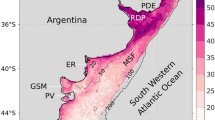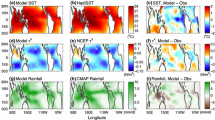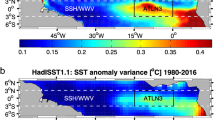Abstract
A total of 52 years of data (1949–2000) from the NCEP/NCAR reanalysis are used to investigate mechanisms involved in forcing and damping of sea surface temperature (SST) variability in the South Atlantic Ocean. Organized patterns of coupled ocean–atmosphere variability are identified using EOF and SVD analyses. The leading mode of coupled variability consists of an SST pattern with a strong northeast–southwest gradient and an SLP monopole centered at 15°W, 45°S. The anomalous winds associated with this monopole generate the SST pattern through anomalous latent heat flux and mixed layer deepening. Other heat flux components and anomalous Ekman transport play only a secondary role. Once established, the SST pattern is attenuated through latent heat flux. The higher SST modes are also induced by anomalous winds and destroyed by latent heat flux. It thus appears that the coupled variability in the South Atlantic Ocean consists of atmospheric circulation anomalies that induce SST anomalies through anomalous latent heat fluxes and wind-induced mixed layer deepening. These SST anomalies are destroyed by latent heat flux with no detectable systematic feedback onto the atmospheric circulation. Atmospheric variability in the South Atlantic is found to be largely independent of that elsewhere, although there is a weak relation with ENSO (El Niño-Southern Oscillation).









Similar content being viewed by others
References
Alexander MA, Deser C (1995) A mechanism for the reoccurrence of wintertime midlatitude SST Anomalies. J Phys Oceanogr 25: 122–137
Barsugli JJ, Battisti DS (1998) The basic effects of atmosphere–ocean thermal coupling on mid-latitude variability. J Atmos Sci 55: 477–493
Bretherton CS, Smith C, Wallace JM (1982) An intercomparison of methods for finding coupled patterns in climate data. J Clim 5: 541–560
Carton JA, Cherupin G, Cao X, Giese B (2000a) A simple ocean data assimilation analysis of the global upper ocean 1950–1995. Part I: methodology. J Phys Oceanogr 30: 294–309
Carton JA, Cherupin G, Cao X, Giese B (2000b) A simple ocean data assimilation analysis of the global upper ocean 1950–1995. Part II: results. J Phys Oceanogr 30: 311–326
Cayan DR (1992) Latent and sensible heat flux anomalies over the Northern Oceans: Driving the sea surface temperature. J Phys Oceanogr 22: 859–881
Da Silva AM, Young CC, Levitus S (1994) Atlas of surface marine data. vol 1, algorithms and procedures. NOAA Atlas Series 6, 74 pp, NOAA, Washington, D.C., USA
Deser C, Blackmon ML (1993) Surface climate variations over the North Atlantic Ocean during winter: 1900–1989. J Clim 6: 1743–1753
Dommenget D, Latif M (2000) Interannual to decadal variability in the tropical Atlantic. J Clim 13: 777–792
Dommenget D, Latif M (2002) A cautionary note on the interpretation of EOFs. J Clim 15: 214–225
Gill AE (1982) Atmosphere–ocean dynamics. Academic Press, San Diego, 1982
Graßl H, Jost V, Kumar R, Schulz J, Bauer P, Schlüssel P (2000) The Hamburg Ocean–Atmosphere Parameters and Fluxes from Satellite Data (HOAPS): a climatological atlas of satellite derived air-sea-interaction parameters over the oceans. Max Planck Institute for Meteorology, Rep 312, Hamburg, Germany
Grötzner A, Latif M, Barnett T (1998) A decadal cycle in the North Atlantic Ocean as simulated by the ECHO coupled GCM. J Clim 11: 841–847
Gordon AL (1986) Interocean exchange of thermocline water. J Geophys Res 91C: 5037–5046
Kalnay E, Kanamitsu M, Kistler R, Collins W, Deaven MI, Gandin L, Iredell M, Saha S, White G, Woollen J, Zhu Y, Chelliah M, Ebisuzaki W, Higgins W, Janowiak J, Mo KC, Ropelewski C, Leetmaa A, Reynolds R, Jenne R, Joseph D (1996) The NCEP/NCAR 40-year reanalysis project. Bull Am Meteorol Soc 77: 437–471
Kushnir Y (1994) Interdecadal variations in North Atlantic sea surface temperature and associated atmospheric conditions. J Clim 7: 141–157
Lass HU, Schmidt M, Mohrholz V, Nausch G (2000) Hydrographic and current measurements in the area of the Angola-Benguela Front. J Phys Oceanogr 30: 2589–2609
Niiler PP, Kraus EB (1977) One-dimensional models of the upper ocean. In: Krauss EB (ed) Modeling and prediction of the upper layers of the ocean. Pergamon, New York, USA, pp 143–172
Okumura Y, Xie S-P, Numaguti A, Tanimoto Y (2001) Tropical Atlantic air-sea interaction and its influence on the NAO. Geophys Res Lett 28: 1507–1510
Robertson AW, Mechoso CR (2000) Interannual and interdecadal variability of the South Atlantic Convergence Zone. Mon Weather Rev 128: 2947–2957
Robertson AW, Mechoso CR, Kim Y-J (2000) The influence of Atlantic sea surface temperature anomalies on the North Atlantic Oscillation. J Clim 13: 122–138
Ruiz-Barradas A, Carton JA, Nigam S (2000) Structure of interannual-to-decadal climate variability in the Tropical Atlantic sector. J Clim 13: 3285–3297
Sterl A, Kattenberg A (1994) Embedding a mixed layer model into an OGCM of the Atlantic: the importance of surface mixing for heat flux and temperature. J Geophys Res 99C: 14,139–14,157
Sterl A (2001a) On the impact of gap-filling algorithms on variability patterns of reconstructed oceanic surface fields. Geophys Res Lett 28: 2473–2476
Sterl A (2001b) On the impact of gap-filling algorithms on variability patterns of reconstructed oceanic surface fields – an update. Proc WCRP/SCOR Workshop on Intercomparison and Validation of Ocean–Atmosphere Flux Fields, 21–24 May, 2001, Potomac, MD, WMO/TD-No. 1083, Geneva, pp 131–134
Sutton RT, Jewson SP, Rowell DP (2000) The elements of climate variability in the tropical Atlantic region. J Clim 13: 3261–3284
Venegas SA, Mysak LA, Straub DN (1997) Atmosphere–ocean coupled variability in the South Atlantic. J Clim 10: 2904–2920
Venegas SA, Mysak LA, Straub DN (1998) An interdecadal climate cycle in the South Atlantic and its links to other ocean basins. J Geophys Res 103C: 24,723–24,736
Wainer I, Venegas SA (2002) South Atlantic multidecadal variability in the climate system model. J Clim 15: 1408–1420
Weijer W, De Ruijter WPM, Sterl A, Drijfhout SS (2002) Response of the Atlantic overturning circulation to South Atlantic sources of buoyancy. Global Planet Change 34: 293–311
Woodruff SD, Slutz RJ, Jenne RL, Steurer PM (1987) A Comprehensive Ocean–Atmosphere Data Set. Bull Am Meteorol Soc 68: 521–527
Xie S-P, Tanimoto Y (1998) A pan-Atlantic decadal climate oscillation. Geophys Res Lett 25: 2185–2188
Zebiak SA, Cane MA (1987) A model El Niño-Southern Oscillation. Mon Weather Rev 115: 2262–2278
Acknowledgements.
The NCEP/NCAR reanalysis data used in this study are freely available from http://ingrid.ldeo.columbia.edu/SOURCES maintained at the International Research Institute for Climate Prediction (IRI). The ocean reanalysis data of Carton et al. (2000a, b) are freely available from the site of J. Carton (http://www.atmos.umd.edu/~Ecarton ). The plotting was done with the free Ferret software developed at NOAA/PMEL/TMAP. We thank an anonymous reviewer for valuable suggestions and Camiel Severijns for the development of most of the software used in preparing this work.
Author information
Authors and Affiliations
Corresponding author
Rights and permissions
About this article
Cite this article
Sterl, A., Hazeleger, W. Coupled variability and air-sea interaction in the South Atlantic Ocean. Climate Dynamics 21, 559–571 (2003). https://doi.org/10.1007/s00382-003-0348-y
Received:
Accepted:
Published:
Issue Date:
DOI: https://doi.org/10.1007/s00382-003-0348-y




